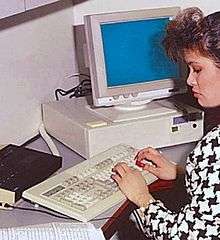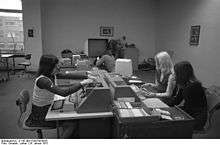Data entry clerk

A data entry clerk is a member of staff employed to enter or update data into a computer system.[1][2][3] Data is often entered into a computer from paper documents[4] using a keyboard.[5] The keyboards used can often have special keys and multiple colors to help in the task and speed up the work.[6]] Proper ergonomics at the workstation is a common topic considered.
The Data Entry Clerk may also use a mouse,[7][8] and a manually-fed scanner may be involved.[9]
Speed and accuracy, not necessarily in that order, are the key measures of the job;[10] it is possible to do this job from home.[11][12]
History

The invention of punch card data processing in the 1890s created a demand for many workers, typically women, to run keypunch machines. It was common practice to ensure accuracy by entering data twice, the second time on a verifier, a separate, keyboard-equipped machine, such as the IBM 056. In the 1970s, punch card data entry was gradually replaced by the use of video display terminals.
Examples
For a mailing company, data entry clerks might be required to type in reference numbers for items of mail which had failed to reach their destination, so that the relevant addresses could be deleted from the database used to send the mail out. If the company was compiling a database from addresses handwritten on a questionnaire, the person typing those into the database would be a data entry clerk. In a cash office, a data entry clerk might be required to type expenses into a database using numerical codes.
Optical character/mark recognition
Due to the advancement of technology, many data entry clerks no longer work with hand-written documents. Instead, the documents are first scanned by a combined OCR/OMR system (optical character recognition and optical mark recognition,) which attempts to read the documents and process the data electronically. The accuracy of OCR varies widely based upon the quality of the original document as well as the scanned image; hence the ongoing need for data entry clerks. Although OCR technology is continually being developed, many tasks still require a data entry clerk to review the results afterward to check the accuracy of the data and to manually key in any missed or incorrect information.
An example of this system would be one commonly used to document health insurance claims, such as for Medicaid in the United States. In many systems, the hand-written forms are first scanned into digital images (JPEG, png, bitmap, etc.). These files are then processed by the optical character recognition system, where many fields are completed by the computerized optical scanner. When the OCR software has low confidence in a data field, it is flagged for review - not the entire record but just the single field. The data entry clerk then manually reviews the data already entered by OCR, corrects it if needed, and fills in any missing data by simultaneously viewing the image on-screen.
The accuracy of personal records, as well as billing or financial information, is usually of great importance to the general public as well as the healthcare provider. Sensitive or vital information such as this is often checked many times, by both clerk and machine, before being accepted.
Job requirements
Accuracy is the highest requirement.[10][13] Staying focused and speed are also needed.[14][15]
Job security
The job is usually low-skilled, so veteran staff are often employed on a temporary basis after a large survey or census has been completed. However, most companies handling large amounts of data on a regular basis will spread the contracts and workload across the year and will hire part-time.
The role of data entry clerks working with physical hand-written documents is on the decline in the developed world, because employees within a company frequently enter their own data, as it is collected now, instead of having a different employee do this task. An example of this is an operator working in a call center or a cashier in a shop. Cost is another reason for the decline. Data entry is labor-intensive for large batches and, therefore, expensive, so large companies will sometimes outsource the work, either locally or to third world countries where there is no shortage of cheaper unskilled labor.[16][17][18]
Education and training
For the job as a data entry clerk, one must possess competent math and English skills.[19] The worker will need to be very familiar with office software such as word processors, databases, and spreadsheets.[19][20] One must have quickness, focus, and great customer service skills.[19]
Education higher than a high school diploma is often not required, but some companies require a bachelor's degree.[20] Companies also hope the worker will have one year of experience in a related field.[20]
Pay
As of 2016, the median pay is between $19,396 and $34,990 in the United States.[20]
References
| Wikimedia Commons has media related to Data entry workers. |
- ↑ "Data Entry Clerk job description template".
We are looking for a Data Entry Clerk to type information into our database
- ↑ "Technology and Its Impact on Employment". 1990.
Data entry is now accomplished via a system of terminals or other input devices
- ↑ "Data Entry Clerk". Boston Center for Independent Living. June 20, 2018.
Enter all data entry documentation into a customized database ... most especially HIPPA
- ↑ https://nationalcareersservice.direct.gov.uk/advice/planning/jobprofiles/Pages/DataEntryClerk.aspx
- ↑ "What is a Data Entry Clerk?".
- ↑ "Data Entry Clerk". Michigan Jobs Portal.
- ↑ J. F. Thomsen (2008). "Carpal tunnel syndrome and the use of computer mouse and keyboard".
- ↑ Cut&Paste/Copy&Paste Data Entry jobs were listed as a category on Indeed.com, a jobs site. There were 244 entries on Aug. 10, 2018 - compared to about 1300 of the type/keyboard types of jobs. "Copy Paste Data Entry Jobs, Employment".
244 Copy Paste Data Entry jobs available on Indeed.com
- ↑ Miracel Griff (2014). Professional Accounting Essays and Assignments. ISBN 1312069317.
Information can be automatically fed, or manually fed into a business accounting ... standard personal computers or workstations running applications; scanning devices for standardized data entry ...
- 1 2 "Data Entry Best Practices to Enhance Data Accuracy". December 2, 2015.
Data accuracy is one of the central attributes that define ... Correct data is critical for the success of ... Hence, accurate data entry is vital to the success of ...
- ↑ Indeed.com listed over a thousand Work-from-home/Work-at-home Data Entry jobs.
- ↑ "Work At Home Data Entry Jobs, Employment". August 10, 2018.
- ↑ "Data Entry Rules" (PDF). Creighton.edu.
Accuracy is more important than speed
- ↑ "Data Entry Clerk". UltimateStaffing.com. February 22, 2018.
The ability to focus for lengthy periods is necessary to eliminate or at least reduce errors
- ↑ D.R. Touron (2014). "Accuracy and speed feedback: Global and local effects".
- ↑ Jennifer Barnes (July 6, 2018). "Opinion: The New Trend in Outsourcing Is Local, Not Overseas".
Many think outsourcing is something that happens overseas, but ... the new trend in outsourcing is local, not overseas.
- ↑ There is another term, Off-shoring: this is not the same as outsourcing
- ↑ "Outsourcing - the emerging trend". August 25, 2009l.
- 1 2 3 "Job Description of Data Entry". NationalCareersService.Direct.Gov. Retrieved April 23, 2016.
- 1 2 3 4 "Most organizations do not require any education higher than a high school diploma". Payscale.com. Retrieved April 23, 2016.